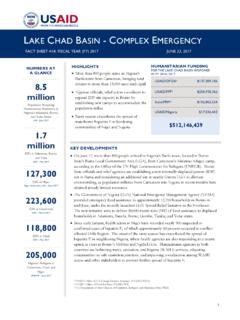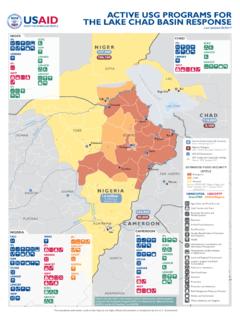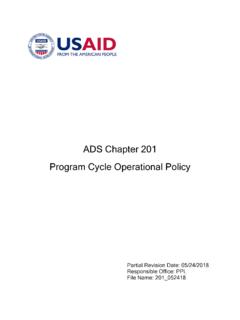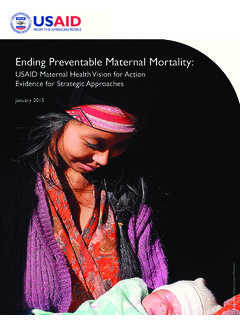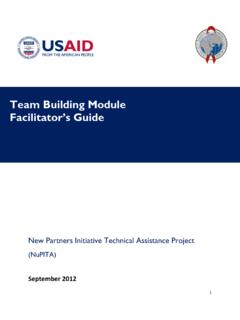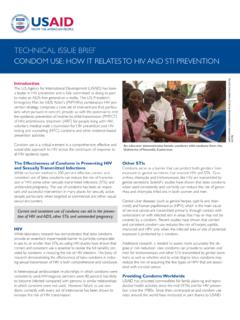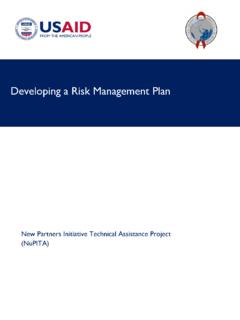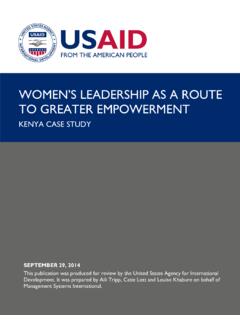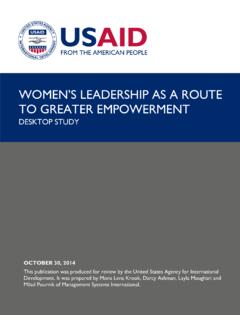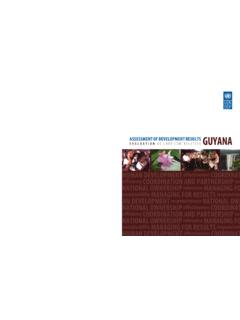Transcription of Laos Health Strategy 2019-2023 - U.S. Agency for ...
1 March 2019 This publication was produced by the United States Agency for International DevelopmentLAOS Health Strategy 2019 - 2023 DISCLAIMER The authors views expressed in this publication do not necessarily reflect the views of the United States Agency for International Development or the United States Government. Additional information is available from: Global Health Program Cycle Improvement Project 1331 Pennsylvania Avenue NW, Suite 300 Washington, DC 20006 Phone: (1-202) 625-9444 Fax: (1-202) 517-9181 This document was submitted by GH Pro to the United States Agency for International Development under USAID Contract No. AID-OAA-C-14-00067. LAOS Health Strategy : 2019 2023 / iii FOREWORD LAOS Health Strategy : 2019 2023 / iv ACKNOWLEDGEMENTS USAID extends its thanks to the Government of Laos for its active participation in development of this first USAID Laos Health Strategy .
2 The Laos Ministry of Health officials at the central, provincial, and district levels worked with USAID from an early stage on all aspects of planning, including all site visits and meetings with government Health offices, provincial and district hospitals, Health clinics, and communities in the provinces of Bokeo, Bolikhamxay, Khammaoune, Houaphanh, Luang Namtha, Oudomxay, Sekong, Xaiyabouly, and Xieng Khouang. We sincerely thank all officials, Health service providers, and community members in each of these provinces for their valuable inputs to the development of this Strategy . USAID would also like to extend its appreciation to the staff of multilateral and bilateral development agencies working in Laos who generously made themselves available to meet with the team developing this Strategy .
3 A list of Health offices, facilities, and development partners who were consulted in development of this Strategy is in Annex 3. USAID extends its thanks for the major contributions and technical support from USAID/Washington Global Health Bureau staff Lily Kak, Emily Hillman, and Laura Itzkowitz; USAID Asia Bureau staff Micaela Arthur and Jean-Jacques Frere; USAID Regional Mission for Asia (RDMA) staff Melissa Jones, David Sintasath, Robin Martz, Tinaflor Chaingam, and Kai Spratt; USAID Laos Country Office staff Alexandra Huerta, Kongchay Vongsaiya, Patrick Bowers, and Manisone Muongsene; Embassy Vientiane staff Souksavanh Mainolath, Soudalay Soukhanouvong, and Khamphet Valakone; and USAID consultants for their invaluable participation in the planning and drafting of this Strategy .
4 LAOS Health Strategy : 2019 2023 / v CONTENTS Foreword .. iii Acknowledgements .. iv vi Executive Summary .. viii 1. Laos context and Health sector overview .. 1 A. Laos social and geographical context .. 1 B. Health systems .. 2 C. Reproductive, Maternal, Newborn, Child and Adolescent Health .. 5 D. Nutrition, water, sanitation, and hygiene (WASH) .. 7 E. Infectious diseases .. 8 F. Disability and mental Health .. 11 G. Current and past USG Health investments .. 12 2. USAID Laos Health Strategy .. 15 A. Guiding principles .. 15 B. Programmatic approaches .. 15 C. Programming priorities .. 16 D. Contextual and programmatic assumptions .. 18 E. Results Framework .. 18 F. Next steps and recommendations.
5 27 Annex 1. Methodology for development of the Laos Health Strategy .. 30 Annex 2. Detailed Facilitate equitable and efficient financing of the Health sector at provincial, district, and Health center levels .. 31 Annex 3. Consultations conducted in developing the Strategy .. 33 Annex 4. Bibliography .. 36 LAOS Health Strategy : 2019 2023 / vi ACRONYMS AIDS Acquired immune deficiency syndrome AMR Antimicrobial resistance AOR Agreement Officer s Representative ART Antiretroviral therapy ARV Antiretroviral ASEAN Association of Southeast Asian Nations CDC United States Centers for Disease Control and Prevention CEP-NTD Control and Elimination Program for Neglected Tropical Diseases CHAS Center for HIV/AIDS and STIs CMPE Center for Malaria, Parasitology.
6 And Entomology DHIS District Health Information System DHO District Health Office EHSP Essential Health Services Program FSWs Female sex workers FY Fiscal Year GDP Gross Domestic Product GF/GFATM Global Fund GHPro Global Health Program Cycle Improvement Project GoL Government of Laos HC Health Center HIV Human Immunodeficiency Virus HSRS Health Sector Reform Strategy HSS Health Systems Strengthening IMF International Monetary Fund LCO USAID Laos Country Office LINKAGES Linkages across the Continuum of HIV Services for Key Populations Affected by HIV LTFU Loss to follow up MCH Maternal and Child Health MDG Millennium Development Goal MDR-TB Multi drug-resistant Tuberculosis LAOS Health Strategy .
7 2019 2023 / vii MNCH Maternal, Newborn, and Child Health MoH Ministry of Health MSM Men who have Sex with Men NGO Non-governmental organization NHI National Health Insurance scheme NTD Neglected Tropical Disease OOP Out-of-pocket (spending on Health ) PDR people s democratic republic PEPFAR President s Emergency Plan for AIDS Relief PHO Provincial Health Office PI Protecting the Investment PLHIV people Living with HIV PMI President s Malaria Initiative PWID people who inject drugs RDMA USAID Regional Development Mission for Asia RMNCAH Reproductive, Maternal, Newborn, Child and Adolescent Health RMNCH Reproductive, Maternal, Newborn, and Child Health SC Save the Children SCH Schistosomiasis SDG Sustainable Development Goals TB Tuberculosis TGW Transgender Women UHC Universal Health Coverage USAID United States Agency for International Development USG United States Government UXO Unexploded Ordnance WASH Water.
8 Sanitation and Hygiene WHO World Health Organization LAOS Health Strategy : 2019 2023 / viii EXECUTIVE SUMMARY Over the past 20 years, Laos has significantly reduced poverty and hunger and improved education and Health outcomes. These successes have been driven by strong economic growth. The benefits of growth have, however, not been evenly distributed among the population. Poverty reduction has lagged significantly behind gross domestic product growth and has varied by location, education, ethnicity, sex, disability status, and occupation. Poverty at 29 percent is significantly higher in rural areas, compared to 10 percent in urban areas, pointing to a pronounced urban-rural divide. Communities from smaller ethnic populations, particularly in rural and remote areas, more commonly experience higher rates of maternal and infant mortality, stunting, and lower secondary school enrollment.
9 The quality and coverage of Health services nationwide remains low. Key challenges are limited access to Health facilities in rural and remote areas, under-resourced and insufficient skilled Health professionals, and under-funding of the Health sector in order to achieve universal Health coverage. Laos key challenge is to utilize the country s economic success to ensure sustained and equitable development that benefits the entire population. The Government of Laos (GoL) stands at a strategic intersection where it can choose between making sound investments to achieve its Sustainable Development Goals or go into even greater debt by borrowing for infrastructure projects that have limited potential to deliver on key development outcomes of benefit to the whole population.
10 To date, USAID s Health investments in Laos have been sporadic and scattered, and have taken place in the absence of an overarching, cohesive Strategy . USAID supports a range of disparate Health activities in Laos, many of which are managed outside the country and some of which are not linked to an overall strategic effort. As a result, this first USAID Health Strategy for Laos seeks to provide a cohesive vision for the Agency s bilateral, regional, and central investments in the Health sector, through building resilience and sustainable capacity and systems to overcome key barriers to development. The development hypothesis that underlies this Strategy is that a healthy and well-educated population will foster resilient, equitable, and prosperous human and economic development for Laos.
